First passenger car design of Mitsubishi
Kiyoshi Honda
I have only heard about the design development of the Mitsubishi 500 from my seniors, but I will summarize the story with some of my own thoughts based on the remaining documents and the notes of Shinichi Mitsuhashi, who knew the situation at the time.
―― National Car Concept as a starting point
In the postwar period, Japan sought economic growth by fostering domestic industries, using the special procurement demand from the Korean War in 1950 as a springboard. As a result of the policy of fostering passenger car production in 1951, companies began to produce foreign cars under license and to develop passenger cars on their own. Against this backdrop, the “National Car Concept” (formally the “National Car Development Outline”) was announced in 1955. This was a call by the government for manufacturers to present their development concepts. The idea was to provide support for the development of one finalist company and have it concentrate on the production of a national car. The criteria included a seating capacity of four, a maximum speed of over 100 km/h, and a price tag of less than 250,000 yen ($694). In the end, this idea was only a call to arms, but at this time Mitsubishi was just getting into the automobile industry with a compact car, and the engineers at the Nagoya Works of the Shin Mitsubishi Heavy Industries were eager to take on this challenge.
―― First passenger car design
Mitsubishi had previously produced several vehicles, mainly trucks and buses, but this was the first time it had developed a full-scale mass-produced passenger car. The design work began in 1956 with a task force-like team led by Masataka Nimura and with Munetaro Shigehiro and Tsutomu Ieda as the main members.
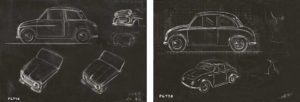
Very first passenger car design sketches of Mitsubishi
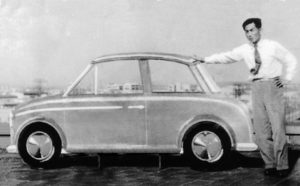
Full-size rendering on plywood and Masataka Nimura
The first step was to draw sketches, followed by 1/1 side view renderings on a piece of plywood to check the styling balance. Then they searched for a place to make the scale models and found a small room by the clock tower on the roof of the company building. The dusty room with cobwebs was turned into a temporary model shop.
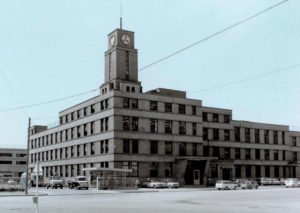
Office building of Shin Mitsubishi Heavy Industries Nagoya Works
In this 10 tatami size room, the team made three 1/10 models using children’s oil clay at school. Proposal A was a flat-deck three-box, Proposal B was a conservative three-box, and Proposal C was a fastback. Shigehiro, who had studied industrial design at an university, recommended proposal A, which had the most prominent flat-deck style that was starting to become popular in the U.S., but the executives decided on proposal B for its conventional look rather than novelty. I think this decision was the least they could make, as the executives had little experience judging car design.
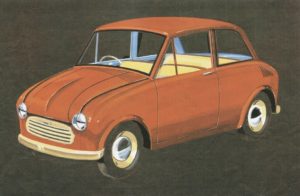
Rendering drawn by Shigehiro in poster color on black drawing paper
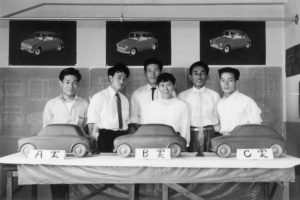
Design team, Nimura (2nd from right), Shigehiro (4th from right), and Ieda (5th from right)
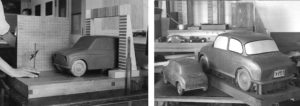
1/10 model (left) Refined 1/5 model with 1/10 model(right)
After the design was decided, they refined the design with a 1/5 model based on the small 1/10 model. Based on this, They created a 1/1 outline drawing using the aircraft drawing technique and produced the output that led to the engineering. Around this time, some engineers and marketing people surveyed the situation of small passenger cars in Europe and were inspired by the popularity of the Fiat 500 there. As a result, it was decided that the 360cc engine, in the category of Kei-car, that had been planned would not be sufficient and that the engine would be replaced with a 500cc engine in a hurry. The new car would be one size larger than Kei-car, but in order to minimize schedule delays, the decision was made to proportionally enlarge the car body without changing its line drawing, much to the displeasure of Nimura, who believed that fine design adjustments were necessary.
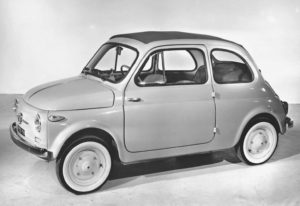
Fiat Nouva 500 launched in 1957 while Mitsubishi 500 is under development
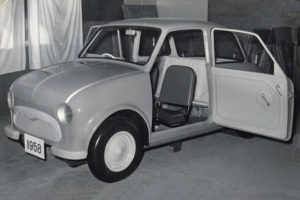
Full-size model made mainly of wood for final design check
During the development process, wind tunnel tests were conducted, which was naturally a first in Japan as it was before other domestic automakers had such facilities. This was at a time when the aerodynamic theory of automobiles itself had not yet been established, and although it could not be compared to today’s level, it was the first step in incorporating aerodynamics into car design. The design process for the Mitsubishi 500 was not based on a specific model, but on the ingenuity of the members. Soon after, in 1961, former GM designer Hans Bretzner was invited to learn American design techniques, and a full-fledged design system was established.
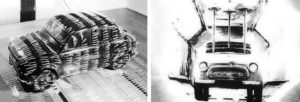
Almost all of the engineers involved in the development of the Mitsubishi 500 had previously been involved in aircraft development. As a result, the design incorporates aircraft-like ideas. The body was a lightweight monocoque structure, and the hood and fenders were welded together, making it look like the fuselage of an aircraft. The roundness of the body also came from the technical concept of using thin sheet metal to provide rigidity. The part corresponding to the front grille was a cover for the spare tire, and the public was invited to design this pattern to promote the car before its launch.
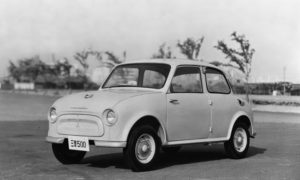
―― Good design that does not sell well
The Mitsubishi 500 was unveiled at the Tokyo Motor Show in the fall of 1959, but just before the show, Typhoon Isewan hit the area and the show cars at the factory were said to be floating in more than 1.5 meters of seawater. However, thanks to the dedicated efforts of everyone involved, the show cars were able to make a successful appearance at the motor show. Although the car was well received at the show, sales were poor afterward. Since it was the very first passenger car, it was judged that the engine performance, handling, and various other technical and usability problems, as well as the design, were not well-received, and a large-scale minor change was started immediately. Nimura and Shigehiro continued to be in charge of the design, which was largely redesigned by adding trunk space at the front and incorporating tail fins, which were popular at the time. Two years later, it was renamed the Colt 600, but this too failed to make up for its inferiority. Around this time, Japan was experiencing a car boom, and Kei-cars such as the Subaru 360 and the Mazda R360 coupe were well received in the market, but the Mitsubishi 500 and Colt 600, both compact cars, were hampered by the disadvantages of the tax system, which seems to have been a considerable hindrance.

Mitusbishi500(left)Colt600(right)
When the Mitsubishi 500 was released, I was a high school student and already had a strong interest in cars. However, the design of this car did not attract me much. I guess I was looking at something new because I was young. Now that I get older and look back, however, I realize that more than half a century after its birth, the rounded form of this car has a high degree of perfection, is well balanced, and is a good design that makes people feel attached to it. Even so, the image of being behind the times was probably a disaster at the time.
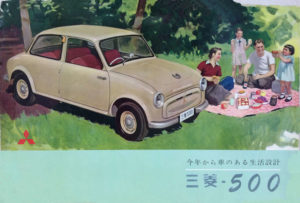
―― Mitsuhashi and Mitsubishi 500
In his second year with the company, Shinichi Mitsuhashi purchased a Mitsubishi 500 Super Deluxe (equipped with the 600 cc engine of its successor) in monthly installments through the employee sales program. Although the car had already been replaced by the Colt 600, Mitsuhashi went into the trouble of choosing the old Mitsubishi 500 from the inventory, and everyone laughed at him as an oddball. It was because he liked the relaxing design of the Mitsubishi 500. The price of 400,000 yen was equivalent to a luxury car worth over 5 million yen today, and although it was a rather drastic purchase, it was worth the joy of owning a car. In those days, the term “private car” was used, and individuals were starting to own cars. As cars became more and more popular, people began to write “driving” in the hobbies section of their self-introductions, and Mitsuhashi used this car to enjoy driving with his friends from Nagoya to distant places such as Mikata Goko and Tojinbo.
Mitsuhashi went on to design the 1st gen. Colt Galant, which catapulted Mitsubishi Motors’ design to the world level. He continued to play a leading role in the design department until his retirement in 1995. Many junior designers aspired to work for Mitsubishi Motors after seeing the appearance of the Colt Galant.
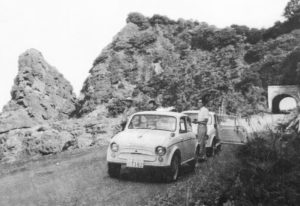
―― First head of design, Masataka Nimura
The Mitsubishi 500 was not a design that was ahead of its time. However, I believe that Nimura’s emotion at being tasked with designing Mitsubishi’s first passenger car may have led him to create such a familiar and pleasing design. Nimura was, as it were, a self-made and dynamic man. He later became the first head of the design and built up the organization for a long period of time. He was involved in the design of most of the cars until the early 1980s, including the Lancer Celeste, and had a great influence on the younger generation. When Nimura retired in 1980, the design department was in full operation with a staff of about 100, six design studios, two exhibition rooms, and a large model shop. Looking back, it was 24 years after starting out in a small, spider-webbed room with a Mitsubishi 500.
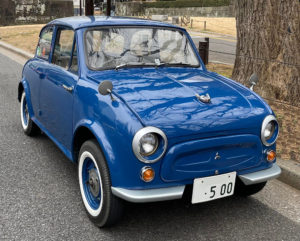
Mitsubishi 500 restored by Masataka Nimura, based on a late model Super Deluxe with early model front end
February 2021